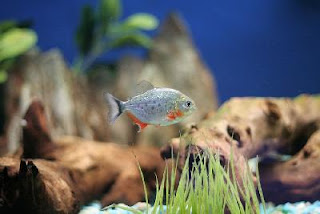The teeth of piranhas are as sharp as scalpel blades,allowing a shoal of these fish to rip apart any unfortunate animal in the water in a matter of minutes, leaving just the bare bones.
Although piranhas can be induced into a feeding frenzy by the presence of blood in the water, this usually only happens under certain conditions—such as when the fish are extremely hungry, if their pool is drying up, or if their prey is injured or struggling to stay afloat. The size of the animal will not stop the piranhas; even horses are likely to be attacked by these fish, and dragged down as they wade into the water. Yet not all piranhas are dangerous, nor is size necessarily an indicator of the risk they pose. Some of the larger species, such as the green tiger piranha, which can grow 17 inches long, are no threat to people. On the other hand, the largest species, the blacktail or Saõ Francisco piranha, is definitely dangerous.
Piranhas rely heavily on their teeth, biting at anything in a feeding frenzy, even bone. This can lead to a piranha breaking its teeth. In some predators this could mean that the animal is no longer able to feed. Luckily for piranhas, however, they are able to grow new teeth to replace damaged ones.
Hard to Identify
It can be quite difficult to tell the difference between the various types of piranhas. This is because they often differ only slightly in color and other features from place to place. It means that many species can easily be confused, and it has resulted in these fish often being known by a variety of common names.
Furthermore, piranhas described under different scientific names have often turned out to be the same species when more detailed studies have been carried out. Piranhas that breed in relatively clear water show clear differences in their coloration and in the appearance of their fins.Males, for example, often appear more brightly colored, as well as being slimmer. Species which spawn in water where visibility is non-existent do not show these differences, however. Instead of spawning in individual pairs, such fish breed in large groups.This increases the likelihood of eggs being fertilized.









1 comments:
lil love in da house n juts wantin 2 ssay we fellas r havin a sleepover @ ma diggy and we want 2 no how deep a parahna lives
Post a Comment